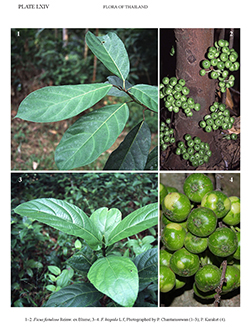e-Flora of Thailand
Volume 10 > Part 4 > Year 2011 > Page 562 > Moraceae > Ficus
SYO3. Ficus fistulosa Reinwwfo-0000688340
ex Blume, Bijdr. Fl. Ned. Ind.: 470. 1825; Miq., Ann. Mus. Bot. Lugd.-Bat. 3: 284, 296. 1867; Kurz, Forest Fl. Burma 2: 459. 1877; King, Ann. Roy. Bot. Gard. (Calcutta) 1(2): 114, t. 150, 151. 1888; Ridl., Fl. Malay Penins. 3: 343. 1924; Gagnep., Fl. Indo-Chine 5: 817. 1928; Corner, J. Malayan Branch Roy. Asiat. Soc. 11: 26, f. 12, 13. 1933: Kochummen, Tree Fl. Malaya 3: 146. 1978; Kochummen, Tree Fl. Sabah & Sarawak 3: 274. 2000; C.C.Berg & Corner, Fl. Males., Ser. 1, Spermat. 17(2): 418. 2005. Plate LXIV: 1–2.
Accepted Name : This is currently accepted.
Description : Tree to 10(–18) m tall. Leafy twigs 3–8 mm thick, (sub)glabrous or sparsely brownish to whitish appressed-puberulous, with nodal waxy glands; internodes hollow or solid; periderm flaking off. Leaves spirally arranged or (partly) subopposite, distichous on ultimate branches; lamina oblong, subobovate or (ob)lanceolate (to elliptic), (4–)8–22(–35) by (1.5–)4–9(–17) cm, symmetrical or asymmetrical, subcoriaceous, apex acuminate to caudate, base cuneate to rounded (to subcordate), margin entire or (in particular towards the apex) ± irregularly dentate, occasionally lobate, usually slightly revolute (towards the base); upper surface (sub)glabrous, smooth, lower surface glabrous or sparsely appressed-puberulous on the veins, smooth, cystoliths only below; lateral veins (4–)6–10(–14) pairs, some of them branched or furcate far from the margin, the basal pair relatively weakly developed, tertiary venation scalariform to subreticulate; waxy glands absent or inconspicuous in furcations of lateral veins; petiole (1–)1.5–3(–10) cm long, glabrous or hirtellous to puberulous, the epidermis flaking off; stipules 0.5–1.5(–2.5) cm long, glabrous or sparsely appressed-puberulous, caducous. Figs axillary, solitary (or in pairs) or sometimes more together on short spurs in the leaf axils and/or below the leaves on short spurs developing into woody tubercles or on branchlets to 4(–10) cm long on the older wood down to the trunk; peduncle (0.5–)1–4.5(–6) cm long; basal bracts 3, (usually) verticillate, 0.5–1 mm long; receptacle subglobose, obovoid or subpyriform, 0.5–1.5 cm diam. when dry, ca 1–2 cm diam. when fresh, mostly 0.1–1 cm long stipitate, (sub)glabrous, lateral bracts absent, sometimes obscurely to distinctly ribbed, yellowish (or red) at maturity, apex ± convex to concave, ostiole ca 1.5–3 mm diam.; internal hairs absent.
Notes: Two varieties can be distinguished in relation to size and apex of the lamina and the position of the figs on the plant.
Ficus tengerensis was reduced to a variety of F. fistulosa. This rather distinct form, mainly occurring in Peninsular Malaysia, is represented by a few collections in Thailand: Niyomdham & Puudjaa 3081 (from Songkhla) and 5522 (from Yala), and Pooma 4421 (from Yala) and 4534 (from Narathiwat).

